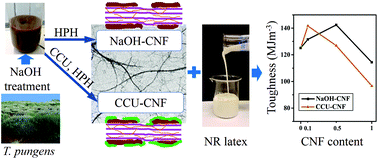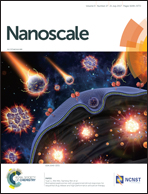Reinforcement of natural rubber latex using lignocellulosic nanofibers isolated from spinifex grass†
Abstract
Reinforcement of natural rubber (NR) using nanofillers often results in an enhancement of the tensile strength, but at the expense of elongation at break and toughness. In this study, with the objective of strengthening NR without compromising its compliance, we investigate the reinforcement efficiency of a series of cellulose nanofibers (CNF) with variations in residual hemicellulose, lignin and therefore surface chemistry. Different types of high aspect ratio CNF isolated from Triodia pungens (T. pungens), an Australian arid grass commonly known as spinifex, were added at 0.1–2 wt% loadings into a pre-vulcanized NR latex. CNF/NR nanocomposites then were benchmarked against NR nanocomposites incorporating a well-known wood-derived CNF. It was found that the presence of residual lignin and hemicellulose, and the pretreatment with a deep eutectic solvent, a mixture of choline chloride and urea (CCU), could increase the compatibility of CNF with the NR matrix, while still enabling stability and handling of the colloidal latex mixture. Incorporation of 0.5 and 0.1 wt% of the sodium hydroxide treated CNF and choline chloride/urea treated CNF into the NR latex showed respectively 11 and 17% enhancement in tensile stress, and importantly without compromising viscoelastic properties; while addition of 0.1 wt% wood-derived CNF resulted in 18% decrease in both tensile stress and strain coupled with more pronounced latex stiffening.



 Please wait while we load your content...
Please wait while we load your content...